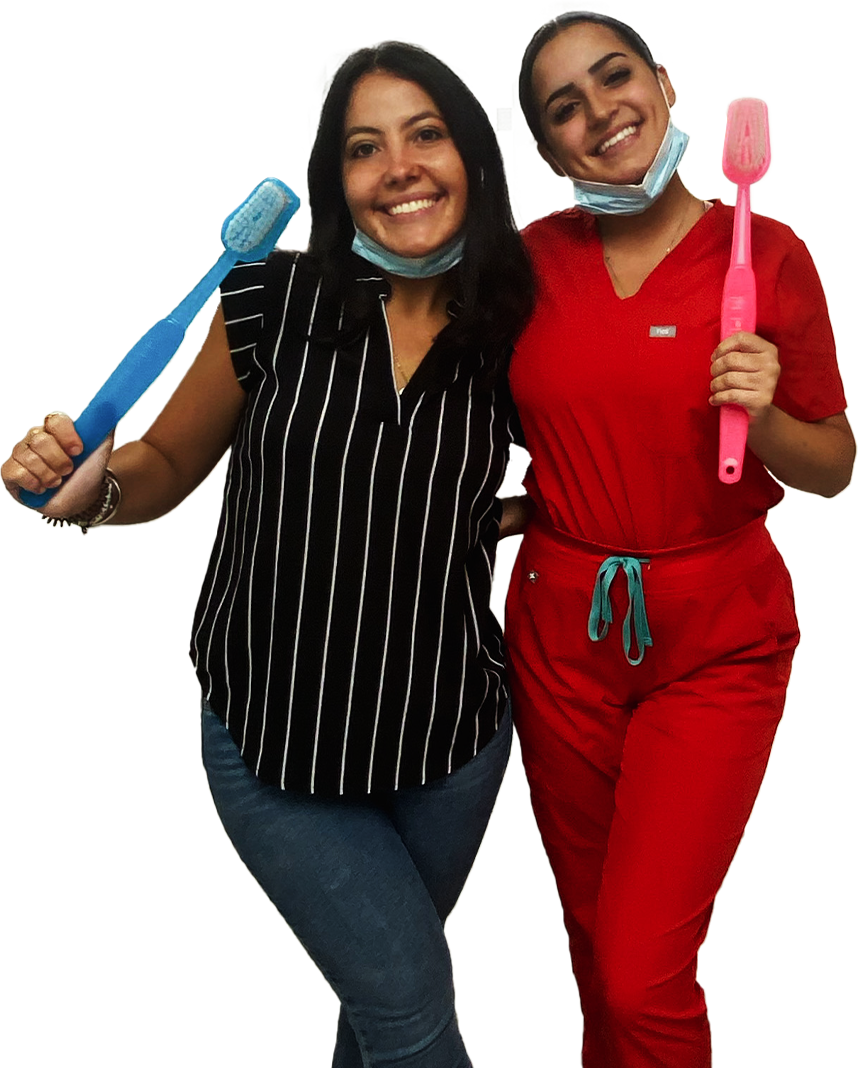Ironbound Dental Center
Orthodontics

Orthodontics
Orthodontics is a branch of dentistry specializing in the diagnosis, prevention, and treatment of jaw, face and bite irregularities (malocclusions*). Orthodontic treatment is provided by an oral health care provider known as an Orthodontist, who has typically completed two to three years of additional training beyond dental school.
Recent years have brought about many changes within the dental industry, specifically with regards to orthodontic treatment and care. Now more than ever patients are experiencing fewer incidences of cavities and missing teeth due to the heightened awareness of fluoride use and preventative dentistry.
Whether it’s traditional braces or custom made removable appliances, orthodontics can help you have the healthy, straight, beautiful smile you’ve been waiting for!
Related Procedures
One of the primary concerns people often have about dental braces is the aesthetic impact of the metalwork on their smile. Especially for adults, the prospect of wearing unattractive metal braces for long periods of time can be very discouraging. Invisalign® offers an almost invisible aligning system that straightens teeth fast and contains no metal.
Invisalign® treatment consists of a series of custom-made aligning trays. The dentist changes the trays every several weeks to fit the new tooth configuration. In addition to the reduced visual impact, Invisalign® aligning trays can be temporarily removed for important occasions – meaning that treatment duration is patient-controlled. A great number of people report complete satisfaction with both the Invisalign® treatment and the stunning results.
What kind of bite problems can Invisalign® correct?
Invisalign® corrects the same dental problems as traditional metal braces; the only difference is that Invisalign® trays are almost invisible to the naked eye, and can be removed at will.
Here are some problems that are commonly corrected with Invisalign®:
- Overcrowding – This occurs when there is too little space for the teeth to align normally in the mouth. Overcrowding can cause tooth decay and increase the likelihood of gum disease.
- Large gaps between teeth – This can sometimes occur because teeth are missing or because the jaw continues to grow abnormally.
- Crossbite – This common dental problem occurs when one or multiple upper teeth bite inside the lower teeth. As a consequence, uneven wear can lead to bone erosion and gum disease.
- Overbite – This problem occurs when the upper teeth project further than, or completely cover, the lower teeth. Eventually, jaw pain and TMJ may occur.
- Underbite – This is the inverse of the overbite; the lower teeth project further than, or completely cover, the upper teeth. Eventually, jaw pain and TMJ can occur.
Orthodontics is one of many dental specialties. The word “orthodontics” is derived from the Greek words orthos, meaning proper or straight and odons meaning teeth. Orthodontics is specifically concerned with diagnosing and treating tooth misalignment and irregularity in the jaw area. Initially, orthodontic treatments were geared toward the treatment of teens and pre-teens, but these days around 30 percent of orthodontic patients are adults.
There are many advantages to well-aligned teeth, including easier cleaning, better oral hygiene, clearer speech and a more pleasant smile. Though orthodontic treatment can be effective at any age, the American Dental Association suggests that an orthodontic assessment should be performed around the age of seven. The earlier orthodontic treatment begins, the more quickly the problem can be successfully resolved.
What problems can be treated with orthodontics?
Orthodontics is a versatile branch of dentistry that can be used alone, or in combination with maxillofacial or cosmetic dentistry.
Here are some of the common conditions treated with orthodontics:
- Anteroposterior deviations – The discrepancy between a pair of closed jaws is known as an anteroposterior discrepancy or deviation. An example of such a discrepancy would be an overbite (where the upper teeth are further forward than the lower teeth), or an underbite (where the lower teeth are further forward than the upper teeth).
- Overcrowding – Overcrowding is a common orthodontic problem. It occurs when there is an insufficient space for the normal growth and development of adult teeth.
- Aesthetic problems – A beautiful straight smile may be marred by a single misaligned tooth. This tooth can be realigned with ease and accuracy by the orthodontist. Alternatively, orthodontists can also work to reshape and restructure the lips, jaw or the face.
A malocclusion is an incorrect relationship between the maxilla (upper arch) and the mandible (lower arch), or a general misalignment of the teeth. Malocclusions are so common that most individuals experience one, to some degree. The poor alignment of the teeth is thought to be a result of genetic factors combined with poor oral habits, or other factors in the early years.
Moderate malocclusion commonly requires treatment by an orthodontist. Orthodontists are dentists who specialize in the treatment of malocclusions and other facial irregularities.
The following are three main classifications of malocclusion:
- Class I – The occlusion is typical, but there are spacing or overcrowding problems with the other teeth.
- Class II – The malocclusion is an overbite (the upper teeth are positioned further forward than the lower teeth). This can be caused by the protrusion of anterior teeth or the overlapping of the central teeth by the lateral teeth.
- Class III – Prognathism (also known as “underbite”) is a malocclusion caused by the lower teeth being positioned further forward than the upper teeth. An underbite usually occurs when the jawbone is large or the maxillary bone is short.
Orthodontists aim to prevent and treat irregularities in the jaw and misalignment of the teeth that are the result of genetics, or develop in accordance with a child’s habits. The best way to achieve these goals is to have your child evaluated by an orthodontist as early as age seven; however, children with noticeable facial irregularities may benefit from preventive orthodontic treatment several years earlier.
Orthodontists are highly trained to notice minute problems with emerging teeth and jaw growth – even if a mixture of baby teeth and permanent teeth are present. While the untrained eye might fail to spot these irregularities, an orthodontic check-up allows for early detection of problems and development of efficient treatment plans.
Some of the key signs that an orthodontic problem is present are as follows:
Difficulty chewing and biting
Jaws that click, shift or make noise as they move
Asymmetry in the face due to disproportionate jaws
Finger and thumb sucking
Bite misalignment (arches of teeth that do not meet properly)
Orthodontics is a specialized branch of dentistry that is concerned with diagnosing, treating and preventing malocclusions (bad bites) and other irregularities in the jaw region and face. Orthodontists are specially trained to correct these problems and to restore health, functionality and a beautiful aesthetic appearance to the smile. Though orthodontics was originally aimed at treating children and teenagers, almost one third of orthodontic patients are now adults. A person of any age can be successfully treated by an orthodontist.
A malocclusion (improper bite) can affect anyone at any age, and can significantly impact the individual’s clarity of speech, chewing ability and facial symmetry. In addition, a severe malocclusion can also contribute to several serious dental and physical conditions such as digestive difficulties, TMJ, periodontal disease and severe tooth decay. It is important to seek orthodontic treatment early to avoid expensive restorative procedures in the future.
What problems can orthodontics treat?
Orthodontics can treat a wide range of dental problems and in most cases, completely realign the teeth. Orthodontists may work alone, or in combination with a maxillofacial surgeon.
The typical irregularities requiring orthodontic treatment are as follows:
- Overcrowding – An overcrowded mouth means there is insufficient space within the jaw for all of the adult teeth to fit naturally. Overcrowding may lead to displaced, rotated or completely misaligned teeth.
- Overbite – An overbite refers to the protrusion of the maxilla (upper jaw) relative to the mandible (lower jaw). An overbite gives the smile a “toothy” appearance and the chin looks like it has receded.
- Underbite – An underbite, also known as a negative underjet, refers to the protrusion of the mandible (lower jaw) in relation to the maxilla (upper jaw). An underbite makes the chin look overly prominent. Developmental delays and genetic factors generally cause underbites and overbites.
Invest in a Smile That Lasts a Lifetime



